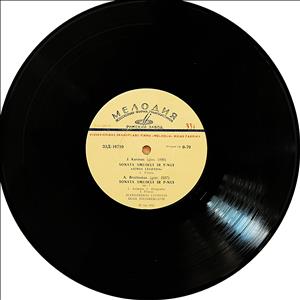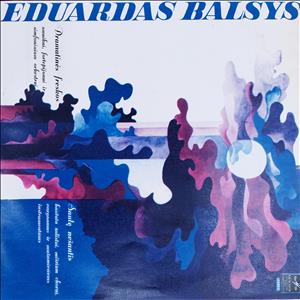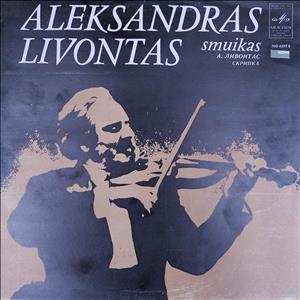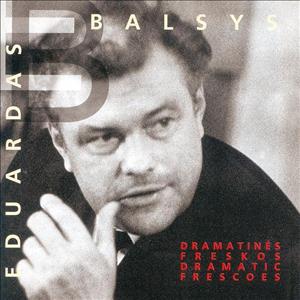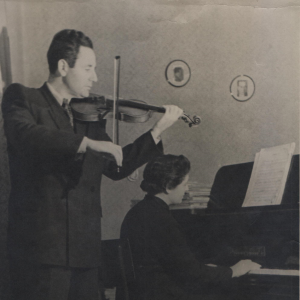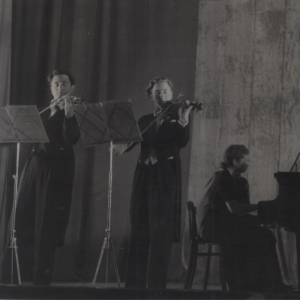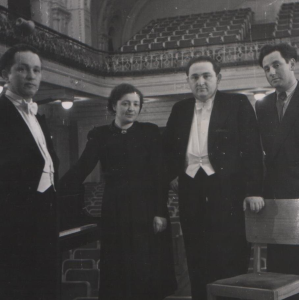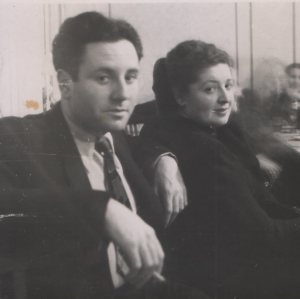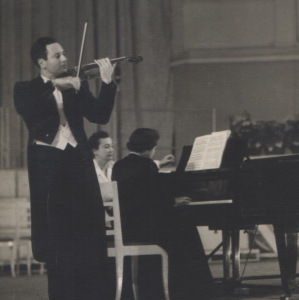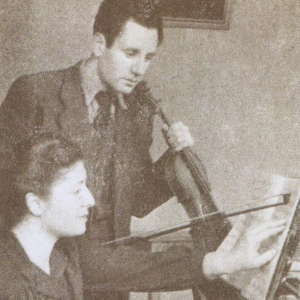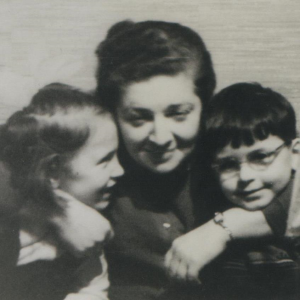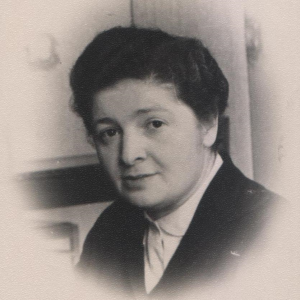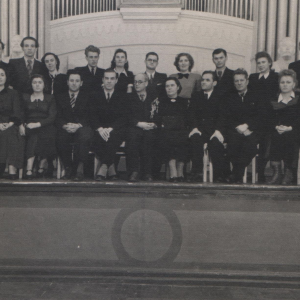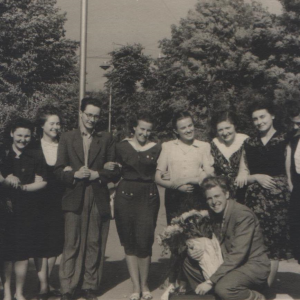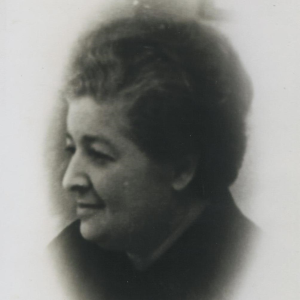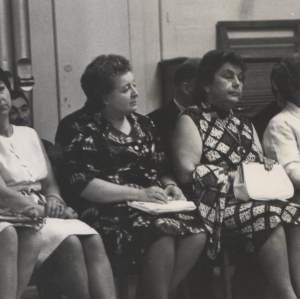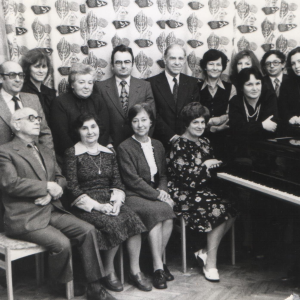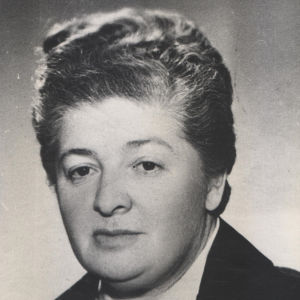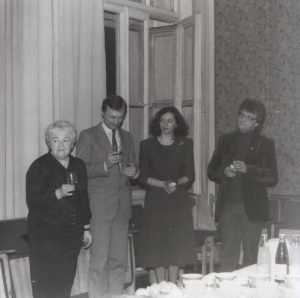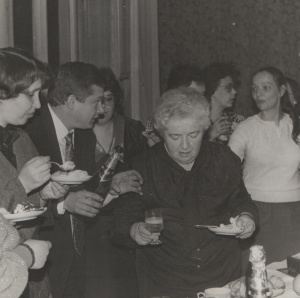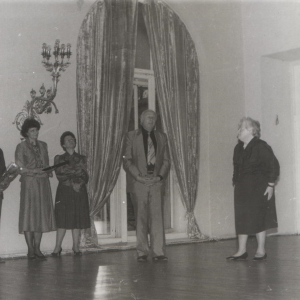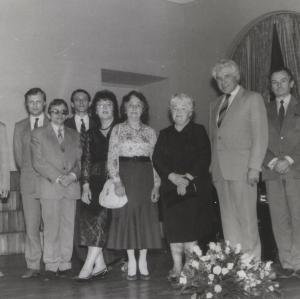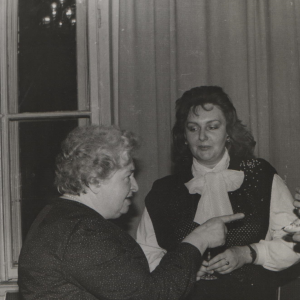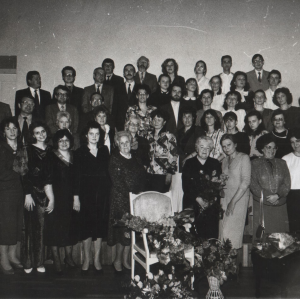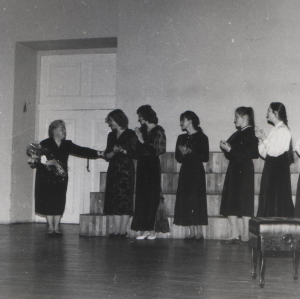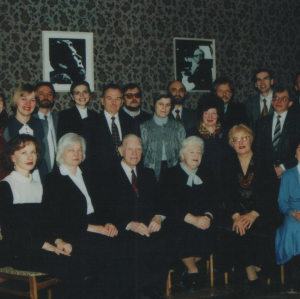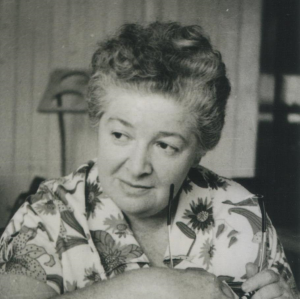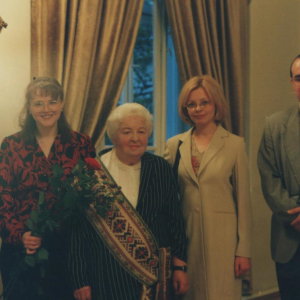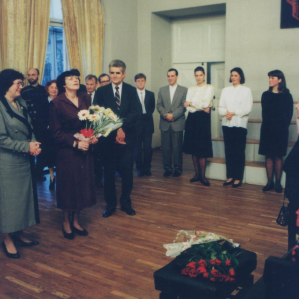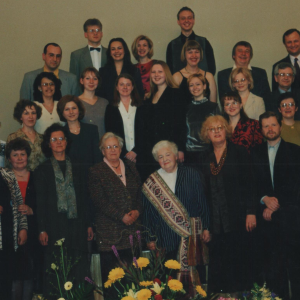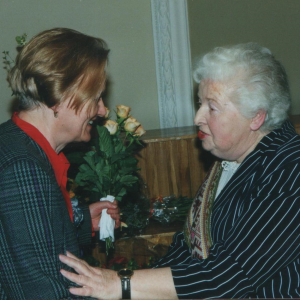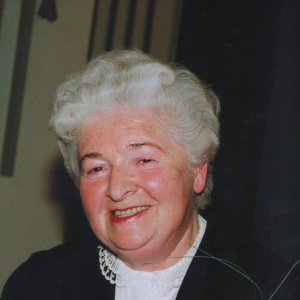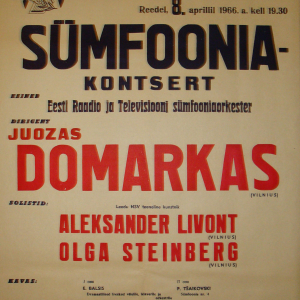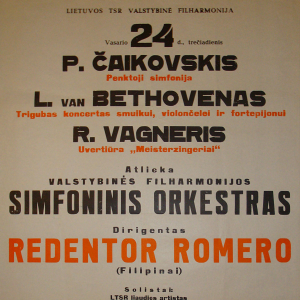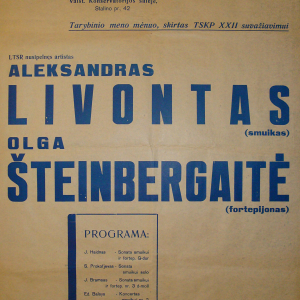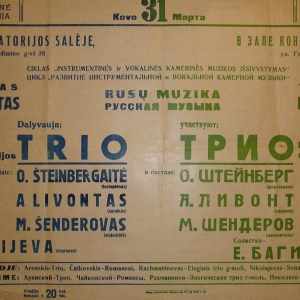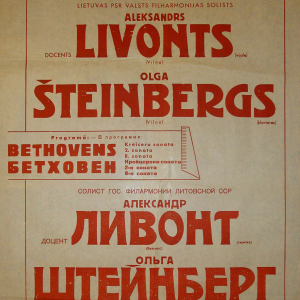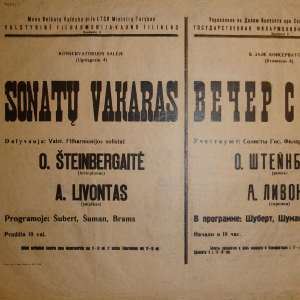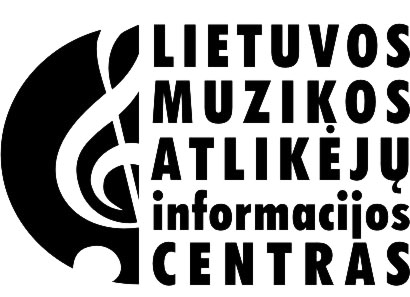
Olga Šteinberg (1920-2005)

Olga Steinberg (Šteinbergaitė) (1920-04-20 Rostov-on-Don (Russia) – 2005-05-22 Vilnius) – a pianist, pedagogue, the professor of the Lithuanian Academy of Music and Theatre who educated almost 130 renowned performers, pedagogues and cultural figures including a number of concert pianists, accompanists, winners of national and international competitions, PhDs. She gave rise to a distinctive school of piano performers.
Steinberg was born on April 20, 1920 to a family of a medical surgeon in Rostov-on-Don. In 1923, the family moved to Odessa. She started playing piano at the age of three; her first teacher was her aunt Sara Kan, a concert pianist. In 1925, she entered the Odessa School of Music, and in 1933 was admitted to a recently opened P. Stoliarsky Ten-Year Music School. She studied piano with prof. Lubove Emanuilovna Sheivachman. Steinberg also took chamber music lessons where she played with violinist A. Livontas, her future husband. The Odessa’s cultural environment, rich concert life and musical traditions had a great influence on the future pianist’s artistic development. In 1939, Steinberg entered the Odessa Conservatory, where she continued her education under the tutelage of prof. Lubove Emanuilovna Sheivachman. However, due to the outbreak of the WWII she had to stop her studies and move with her mother (she had already lost her father) to Kazan and later to Udmurtia. Steinberg worked at the Izhevsk Musical Comedy Theatre, where she gained a great sight-reading experience. This had helped her on her entrance exams to Sverdlovsk Conservatory in 1942, where she studied with G. Neuhaus. In 1943–47, she continued her education under Yakov Zak at the Tchaikovsky Conservatory in Moscow. At the aforementioned Conservatory she acquainted herself with and developed understanding of piano mastery, expanded her competence in piano repertoire, and augmented her erudition in music and art.
Steinberg graduated from the Tchaikovsky Conservatory cum laude and was offered to stay and work in Moscow, but in 1947 she joined her husband violinist A. Livontas in Lithuania where he already had his position as a violinist. Young and promising musicians not only stayed in Lithuania, but also greatly contributed to the development of Lithuanian music culture and education of music professionals. Moreover, they both gave rise to Lithuanian school of violin and piano playing.
In the beginning Steinberg was a soloist with and accompanist at the Kaunas Philharmonic. In 1948, she started teaching the accompaniment and piano as a mandatory instrument at the Kaunas Conservatoire. In 1949, Steinberg moved to Vilnius where she taught the piano, accompaniment and piano as a mandatory instrument at the Lithuanian State Conservatoire. In 1950, she joined the faculty of the Vilnius Ten-Year Music School (presently the National M. K. Čiurlionis School of Art).
In 1975, she was granted the status of the associate professor and in 1985 – professor.
For three decades Steinberg was actively performing as a soloist and chamber musician. As a soloist with the symphony orchestra she performed the staple repertoire. She appeared not only around Lithuania, but also throughout the Soviet Union. Her repertoire included works by Händel, J.S. Bach, Mozart, Beethoven, Liszt, Franck, Tchaikovsky, Rachmaninov and Prokofiev. Together with singer A.E. Bagyeva she presented concert series “16th–20th c. vocal chamber works”, with A. Livontas performed all violin sonatas by Beethoven. She encouraged Lithuanian composers to write new opuses and premiered them. Steinberg saw her mission in promulgating the Lithuanian music, represented Lithuania not only in the concert halls of the then Soviet Union, but also abroad. She did her best to be part of the Lithuanian music culture and the social circle, Lituanized her last name and therefore was known as Šteinbergaitė. Her friendship with B. Dvarionas and E. Balsys resulted in emergence of B. Dvarionas’ 2nd Violin Concerto and E. Balsys’ Dramatic Frescoes. She performed works by J. Karosas, V. Klova, G. Kuprevičius, A. Račiūnas, R. Žigaitis, St. Vainiūnas, etc. Her contemporaries praised her outstanding pianism, professionalism and artistry, the unity of content and form in her performances, temperate expression, deep knowledge of technique of both piano art and performance.
Steinberg’s stage partners included singers A. Staškevičiūtė, J. Petraškevičiūtė and R. Tumalevičiūtė, cellists P. Berkavičius and M. Šenderovas, oboist Romualdas Džiugas, clarinettist Juozas Jasenka and bassoonist Vladas Kairys. She gave many a concert with her husband violinist A. Livontas. The duo’s repertoire embraced all available at the time Lithuanian music for violin and piano. Majority of Lithuanian composers dedicated their works to this duo.
Prof. E. Ignatonis wrote about A. Livontas and O. Steinberg Duo: “They were similar in terms of artistic ideals, but very different as personalities (a feature of a real duo): the violinist was impulsive, continuously in motion and imposingly emotional, while the pianist embodied the Olympic tranquillity and displayed a withdrawal into “a second dais” (whereas actually it was a nicely hidden control, apparent assurance of her idea).” (p.49)
After her husband violinist A. Livontas passed away in 1974, Steinberg dedicated herself to pedagogical work – the education of pianists-performers. The graduate of the Moscow Conservatory she brought to Lithuania the main teaching principles of her Alma Mater – a respect for the composer’s text, an endeavour to unite content and form, professionalism, high artistic standards, which she inherited from her teacher prof. Y. Zak. Uttermost attention to and respect for a composer’s idea, understanding of music as the whole, which is achieved via exhaustive analysis of a work performed, cultivation of the pianist’s inner ear and technique are characteristic of Steinberg’s school. The Professor had a brilliant command of new approaches to the art of performing and pedagogy; in her work with students she enriched her perpetual perfecting of piano methods with her own stage experience, high competence in the subtleties of piano art and wide approach to the piano repertoire. She paid great attention to communication with her students – the pedagogue was insightful of the existing and to be developed capabilities of every student, was mindful of individuality and needs of every of her student. A personality of high culture, intellect, sensitivity, insistence on a high standard, wide erudition she educated individuals of wide horizons. In over fifty years (until 2003) she coached a great number of performers, pedagogues and accompanists. The list of almost 80 of Steinberg’s piano graduates includes V. Vitaitė, A. Juozapėnaitė-Eesmaa, M. Rauchaitė, R. Aleknaitė-Bieliauskienė, A. Žvirblytė, A. Motuzienė, Ž. Karkauskaitė, S. Kondrotaitė, R. Bekionis, D. Balsytė, L. Bakienė and G. Kėvišas among others. The Professor’s accompanying class included pianists G. Ručytė-Landsbergienė, V. Landsbergis, E. Ignatonis, H. Znaidzilauskaitė, B. Vasiliauskas, the class of the piano as a mandatory instrument – S. Sondeckis, J. Urba and J. Finkelšteinas.
Spread around the world Steinberg’s disciples, pianists and pedagogues, are nurturing her artistic legacy and carrying on with the Professor’s piano art tradition.
In 1970, Steinberg was honoured with the title of the Distinguished Artist of the LSSR; in 2000, for her contributions to Lithuania she was decorated with the Order of the Lithuanian Grand Duke Gediminas.
Professor O. Steinberg died on May 22, 2005. Buried next to her husband violinist A. Livontas in Antakalinis Cemetery in Vilnius.
Written by Aldona Juodelienė
Lithuanian Composers
E. Balsys
„Dramatic frescoes“ for violin, piano and symphony orchestra
Suite for violin and piano from Ballet „Eglė Queen of the Grass-snakes“
Concerto for violin and orchestra No. 1
Concerto for violin and orchestra No. 2
A. Bražinskas
Sonata for violin and piano, op. 7
M. K. Čiurlionis
Three Preludes (for violin and piano), in A minor, B flat minor, F major
B. Dvarionas
Concerto for violin and orchestra in B minor
J. Gruodis
Sonata for violin and piano
B. Gorbulskis
Two Pieces from Suite for piano
Suite for piano
J. Karosas
"The Sea Legend", sonata for violin and piano
Lithuanian Dances Suite for violin and piano
Suite for violin and piano
V. Klova
10 Pieces for piano
G. Kuprevičius
Sonatina in Classical Style for violin and piano
V. Paltanavičius
Sonata for violin and piano
J. Pakalnis
Adagio from Ballet „Fiancee“
A. Račiūnas
Sonata for violin and piano
R. Žigaitis
Sonatina for piano
Foreign Composers
L. Auster
Fragment from Ballet „Tina“
L. van Beethoven
Sonatas for violin and piano
C. Franck
Concerto for piano and orchestra
Symphonic Variations
M. Glinka
Pathetics Trio in D minor for piano, clarinet and bassoon
F. Liszt
Concerto for piano and orchestra
P. Tchaikovsky
Concerto for piano and orchestra No. 2
W. A. Mozart
Piano Trio in E flat major
“Chamber music was her element, and her overall concert career was inseparable from her husband A. Livontas. Steinberg and Livontas Duo remains in my memory as an example of ideal ensemble playing. Being of a very different artistic nature even opposite to one another they achieved a magnificent concord through diligent artistic undertakings and high professionalism. Livontas’ virtuoso, impulsive, fiery and temperamental violin always found fundament in Steinberg’s tempered interpretation based on logic.”
(Saulius Sondeckis. Didžiuojuosi, kad ir man teko būti O. Šteinberg mokiniu. (I am proud to have been a disciple of O. Steinberg) From: „Akimirkos su pianiste Olga Šteinberg“, p. 88)
“Especially noteworthy was the Professor’s outstanding pianism: as a performer she stood out for the ability to precisely adhere to the musical text of a performed work, technical perfection, beautiful tone, logical rendering of the musical works. <…> aim at high standards of quality was characteristic of both her performing art and her pedagogical work.”
